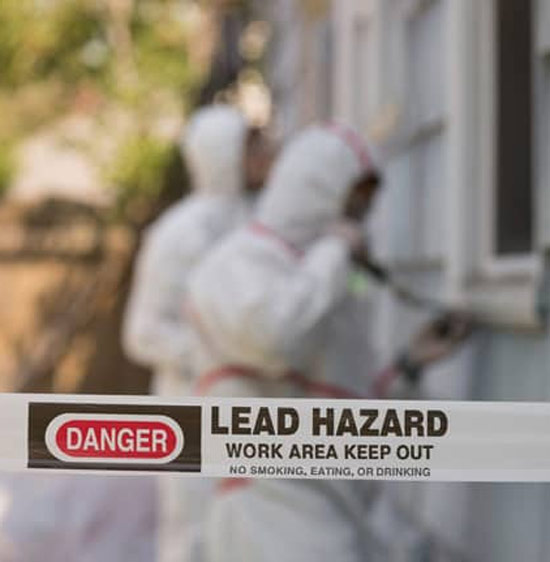Comprehensive Guide on Effective Lead Infraction Elimination Methods
In the realm of ecological safety and security, addressing lead infractions demands a careful and organized strategy. This comprehensive guide begins by highlighting the important first actions of recognizing lead risks via innovative assessment and testing approaches. Techniques such as XRF analysis and dust wipe sampling are important in identifying contamination sources. The guide clarifies on the relevance of sticking to rigorous safety and security methods during the removal process, consisting of the use of appropriate PPE and isolating affected locations. The succeeding sections promise to review post-removal confirmation and preventive strategies, making certain lasting security and compliance. Discover the detailed information that make these methods not just reliable but crucial.
Recognizing Lead Risks
Determining lead dangers is an important initial action in alleviating the risks linked with lead exposure. Lead, a harmful steel, can be present in different environmental mediums, including paint, dirt, water, and dirt.
The preliminary phase in identifying lead risks entails recognizing typical lead sources within the built setting. Structures developed prior to 1978 are especially vulnerable due to the widespread use lead-based paint during that duration. Additionally, soil contamination can happen from wearing away exterior paint, industrial emissions, or historic use leaded gas.
One more substantial resource is lead piping and pipes components, which can leach lead right into drinking water. Consumer products such as playthings, porcelains, and imported items may additionally have harmful lead levels. Significantly, work environments and hobbies including lead can track contaminants right into homes.
Analysis and Testing
When dealing with lead threats, efficient analysis and testing are extremely important. Preliminary analysis usually includes a visual evaluation to determine possible lead sources, such as weakening paint or infected dirt.

Dust wipe tasting is an additional crucial method, specifically in residential settings. By accumulating examples from floors, windowsills, and other surfaces, this technique supplies understandings right into potential exposure risks. Additionally, dirt screening around structure perimeters is necessary to find lead contamination that can posture hazards, especially to kids.
Safe Removal Procedures
Upon completing extensive evaluation and testing, executing safe removal procedures is the next critical phase in resolving lead threats. This procedure makes sure that lead-contaminated products are efficiently and safely eradicated, reducing risk to both employees and citizens. The very first step involves separating the afflicted area making use of plastic sheet and appropriate securing methods to stop the spread of lead dust.
Employees must wear proper personal protective get more tools (PPE), including respirators, gloves, and non reusable coveralls, to reduce exposure. Using specialized tools and wet methods, such as damp sanding or using HEPA-filtered vacuum cleaners, decreases the diffusion of lead bits. It is essential to stay clear of completely dry fining sand or abrasive blowing up, as these approaches can create dangerous lead dust.
Garbage disposal is one more essential element; all contaminated products must be firmly nabbed and classified according to EPA and local laws. Additionally, thorough cleansing of the workplace with HEPA vacuums and damp wiping guarantees the elimination of residual lead bits.
Post-Removal Confirmation

Confirmation of effective lead removal, known as post-removal verification, is vital to make sure the safety and security and habitability of the remediated location. This examination makes certain index that all well-known resources of lead have actually been dealt with and that no visible indications of contamination stay.
Complying with the visual evaluation, environmental sampling is conducted. This entails gathering dust, dirt, and occasionally water examples from the remediated location. Recognized labs evaluate these samples to gauge lead degrees, guaranteeing they fall below the safety limits developed by regulative bodies such as the Epa (EPA)
On top of that, more helpful hints air high quality testing might be done to find airborne lead particles, specifically in situations where comprehensive lead-based paint removal or restoration has actually taken place. The outcomes of these examinations give measurable data validating that the lead levels are within permissible restrictions.
Eventually, post-removal verification functions as a crucial checkpoint, confirming the efficiency of the lead abatement initiatives and safeguarding the wellness of residents and site visitors.
Preventative Procedures and Upkeep

A crucial safety net consists of making use of lead-safe licensed service providers for any kind of remodelling, repair, or painting tasks. These specialists are learnt practices that decrease lead dirt and debris. Furthermore, keeping painted surfaces to prevent chipping or peeling off is essential, as weakening paint can release lead fragments into the atmosphere.
Educational campaigns targeting homeowner and renters concerning the threats of lead and the value of reporting any type of potential hazards can better enhance preventative initiatives. Regular cleansing utilizing HEPA vacuums and wet wiping strategies can substantially minimize lead dust accumulation.
Conclusion
In summary, reliable lead offense elimination necessitates a precise technique including thorough assessment, precise testing, and stringent removal treatments. Ensuring safety via correct seclusion and individual safety devices remains extremely important. Post-removal confirmation via environmental tasting and air top quality screening corroborates conformity with well-known safety requirements. Moreover, ongoing examinations and upkeep are important to reduce future lead hazards, thereby securing public health and ensuring continual compliance with regulative demands.